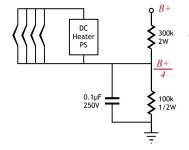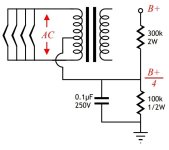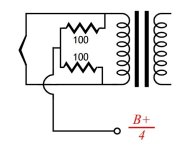Do i feed positive and negative to the filament ör just positive voltage if someone can elaborate it
İ am using DC voltage btw
İ know its probably stupid question thanks in advance
İ am using DC voltage btw
İ know its probably stupid question thanks in advance
Last edited:
I don't know what are you asking. Live and neutral are 110 or 220V, what are your filaments rating?
The difference across the heater filament should be 6.3v, in this instance. Other tubes may require different voltages, anywhere from 2.5v-26v, maybe higher.
It's very common to use AC to power the filament. A transformer will step down the mains voltage to 6.3v. if the transformer is center-tapped, it will be rated 3.15-0-3.15v so you'll see 6.3v across the filament. The center tap is vital to ensure a common 0v reference voltage for all electrodes in the tube.
If the Cathode voltage is very high, you may need to "Elevate" the voltage to avoid violating H-K limits of the tube. By introducing a 50vDC voltage via the center-tap you could supply 50-56.3v across the filament. The difference across the filament is still 6.3v, but that median voltage is 53.15v.
Ok, DC. You still need to feed the tube 6.3v, the heater needs that 6.3v difference in potential. So you can give one pin +6.3vDC and the other 0v. Or you could give one pin -6.3vDC and the other pin 0v. Or....
As long as your potential difference is 6.3v, you're good.
Always measure the heater voltage when your amp is working normally. If you're more than 10% above or below 6.3v, fix it or you'll shorten the life of the tube.
W
It's very common to use AC to power the filament. A transformer will step down the mains voltage to 6.3v. if the transformer is center-tapped, it will be rated 3.15-0-3.15v so you'll see 6.3v across the filament. The center tap is vital to ensure a common 0v reference voltage for all electrodes in the tube.
If the Cathode voltage is very high, you may need to "Elevate" the voltage to avoid violating H-K limits of the tube. By introducing a 50vDC voltage via the center-tap you could supply 50-56.3v across the filament. The difference across the filament is still 6.3v, but that median voltage is 53.15v.
Ok, DC. You still need to feed the tube 6.3v, the heater needs that 6.3v difference in potential. So you can give one pin +6.3vDC and the other 0v. Or you could give one pin -6.3vDC and the other pin 0v. Or....
As long as your potential difference is 6.3v, you're good.
Always measure the heater voltage when your amp is working normally. If you're more than 10% above or below 6.3v, fix it or you'll shorten the life of the tube.
W
If you are building a power amp AC will likely be OK on the filaments, You can still float them, see Filament float 2 attached. If you don't have a centre tap on your heater supply one can be simulated with 2 resistors, see Filament Float 3. You will still need the two resistors and cap like on Filament Float 2.
Attachments
alright thank you,The difference across the heater filament should be 6.3v, in this instance. Other tubes may require different voltages, anywhere from 2.5v-26v, maybe higher.
It's very common to use AC to power the filament. A transformer will step down the mains voltage to 6.3v. if the transformer is center-tapped, it will be rated 3.15-0-3.15v so you'll see 6.3v across the filament. The center tap is vital to ensure a common 0v reference voltage for all electrodes in the tube.
If the Cathode voltage is very high, you may need to "Elevate" the voltage to avoid violating H-K limits of the tube. By introducing a 50vDC voltage via the center-tap you could supply 50-56.3v across the filament. The difference across the filament is still 6.3v, but that median voltage is 53.15v.
Ok, DC. You still need to feed the tube 6.3v, the heater needs that 6.3v difference in potential. So you can give one pin +6.3vDC and the other 0v. Or you could give one pin -6.3vDC and the other pin 0v. Or....
As long as your potential difference is 6.3v, you're good.
Always measure the heater voltage when your amp is working normally. If you're more than 10% above or below 6.3v, fix it or you'll shorten the life of the tube.
W
So 6.3v positive and ground would do
If it is AC, positive and ground terms are meaningless.alright thank you,
So 6.3v positive and ground would do
They change places every 18 or 20 milliseconds! 😎
Jan
Last edited:
- Home
- Amplifiers
- Tubes / Valves
- Question about filament voltage on push pull


